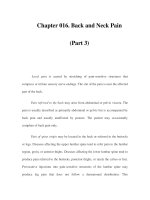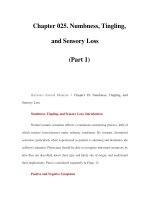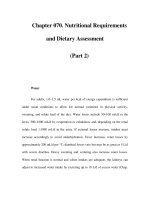Chapter 116. Immunization Principles and Vaccine Use (Part 3) pps
Bạn đang xem bản rút gọn của tài liệu. Xem và tải ngay bản đầy đủ của tài liệu tại đây (15.03 KB, 5 trang )
Chapter 116. Immunization Principles
and Vaccine Use
(Part 3)
The Immune Response
While many constituents of infectious microorganisms and their products
(e.g., exotoxins) are or can be rendered immunogenic, only some stimulate
protective immune responses that can prevent infection and/or clinical illness or
(as in the case of rotavirus) can attenuate illness, providing protection against
severe disease but not against infection or mild illness. The immune system is
complex, and many factors—including antigen composition and presentation as
well as host characteristics—are critical for stimulation of the desired immune
responses (Chap. 308).
The Primary Response
The primary response to a vaccine antigen includes an apparent latent
period of several days before immune responses can be detected. Although the
immune system is rapidly activated, it takes 7–10 days for activated B
lymphocytes to produce enough antibody to be detected in the circulation. The
primarily IgM antibodies seen initially are rapidly produced but have only a low
affinity for the antigen. After the first week, high-affinity IgG antibodies begin to
be produced in quantity; this switch from IgM to IgG production requires the
participation of CD4+ T-helper lymphocytes—the "middle men" of the immune
response. Because precursors for T cells mature within the thymus gland, antigens
that stimulate T cells are referred to as T or thymus-dependent antigens.
Circulating antigen-specific T lymphocytes that implement cell-mediated immune
responses are identified in the peripheral bloodstream only after several days but
begin to increase in number immediately after antigenic stimulation.
Activation of these responses typically requires co-recognition of the
antigen by specific molecular species of HLA, the major histocompatibility
complex, which is present on the surface of lymphocytes and macrophages. Some
individuals cannot respond to one or more antigens, even when repeatedly
exposed, because they do not have the genes for the particular HLA type involved
in antigen recognition, processing, and presentation for an immune response. This
situation is known as primary vaccine failure.
The Secondary Response
Stronger and faster humoral or cell-mediated responses are elicited by a
second exposure to the same antigen and are detectable within days of the
"booster" dose. The secondary response depends on immunologic memory
induced by the primary exposure and is characterized by a marked proliferation of
IgG antibody–producing B lymphocytes and/or effector T cells. Pure
polysaccharide antigens, such as the first-generation pneumococcal vaccine, evoke
immune responses that are independent of T cells and are not enhanced by
repeated administration. However, conjugation of the same polysaccharide to a
suitable protein converts the carbohydrate antigen into one that is T cell–
dependent and able to induce immunologic memory and secondary responses to
reexposure. Although levels of vaccine-induced antibodies may decline over time,
revaccination or infection generally elicits a rapid (anamnestic) protective
secondary response consisting of IgG antibodies, with little or no detectable IgM.
Thus, a lack of measurable antibody in an immunized individual does not
necessarily indicate secondary vaccine failure. Similarly, the mere presence of
detectable antibodies after immunization does not ensure clinical protection: the
level of circulating antibody may need to exceed a threshold value in order to
mediate protection (e.g., 0.01 IU/mL for tetanus antitoxin).
Mucosal Immunity
Some pathogens are confined to and replicate only at mucosal surfaces
(e.g., Vibrio cholerae), whereas others first encounter the host at a mucosal surface
before they invade systemically (e.g., influenza virus). A distinctive
immunoglobulin, secretory IgA, is produced at mucosal surfaces and is adapted to
resist degradation and to function at these sites. Vaccines may be specifically
designed to induce secretory IgA and thereby to block the essential initial steps in
disease pathogenesis that occur on mucosal surfaces. Given its complexity,
mucosal immunology has become a separate branch of the field of immunology.
Measurement of the Immune Response
Immune responses to vaccines are often gauged by the concentration of
specific antibody in serum. Although seroconversion (i.e., transition from
antibody-negative to antibody-positive status) serves as a dependable indicator of
an immune response, it does not necessarily correlate with protection unless serum
antibody is the critical mechanism in vivo and the levels achieved are sufficient
(e.g., against measles). In some instances, serum antibody correlates with clinical
protection but does not directly mediate it (e.g., vibriocidal serum antibodies in
cholera).
Herd Immunity
Successful vaccination protects immunized individuals from infection,
thereby decreasing the percentage of susceptible persons within a population and
reducing the possibility of infection transmission to others. At a definable
prevalence of immunity, an infectious organism can no longer circulate freely
among the remaining susceptibles. This indirect protection of unvaccinated
(nonimmune) persons is called the herd immunity effect; through this effect,
vaccination programs may confer societal benefits that exceed individual costs.
The level of vaccine coverage needed to elicit herd immunity depends on the
patterns of interaction among individuals within the population and the biology of
the specific infectious agent. For example, measles virus and VZV have high
transmission rates and require a higher level of vaccine coverage for herd
immunity than do organisms with lower transmission rates, such as S.
pneumoniae. Wherever herd immunity for poliomyelitis and measles has been
induced with vaccines, transmission of infection has ceased; however, herd
immunity may wane if immunization programs are interrupted (as was the case for
diphtheria in the former Soviet Union) or if a sufficient percentage of individuals
refuse to be immunized because of a fear of vaccine-related adverse events (as
occurred for pertussis in the United Kingdom and Japan). In either setting, the loss
of herd immunity has led to renewed circulation of the organism and subsequent
large outbreaks with serious consequences.









